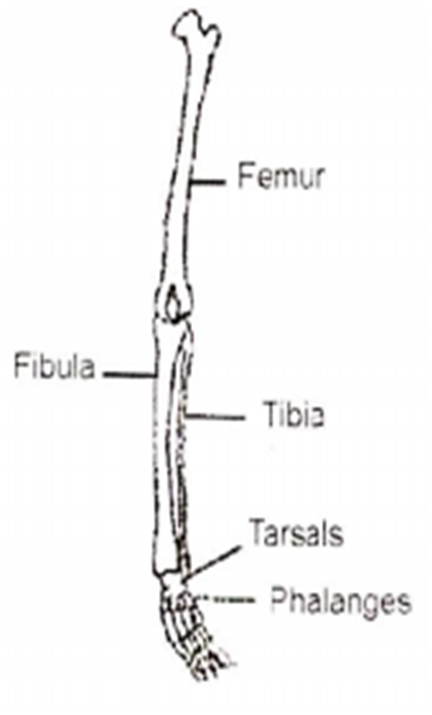 Multiple Choice Questions
Multiple Choice QuestionsWhat is diapedesis?
A kind of amoeboid movement.
The process of filtration of urea in kidney.
A type of locomotion found in Hydra
Migration of WBCs into the tissue spaces from blood capillaries
Skeletal muscles appear striated due to presence of two characteristic proteins in alternating dark and light bands. Which of the following is a correct match of the protein with its light refractive property and colour
| Protien | Colour | Property |
| Myosin | Light | Anisotropic |
| Actin | Dark | Anisotropic |
| Myosin | Dark | Isotropic |
| Actin | Light | Isotropic |
A cricket player is fast chasing a ball in the field. Which one of the following groups of bones are directly contributing in this movement
Femur, malleus, tibia, metatarsals
Pelvis, ulna, patella, tarsals
Sternum, femur, tibia, fibula
Tarsals, femur, metatarsals, tibia
Given diagram shows bone of the left human hindlimb as seen from front. It has certain mistakes in labeling. Two of the wrongly labelled bones are

tibia and tarsals
femur and fibula
fibula and phalanges
tarsals and femur
Assertion: Eukaryotic cells have the ability to adopt a variety of shapes and carry out directed movements.
Reason: There are three principal types of protein filaments - microfilaments, microtubules and intermediate filaments, which constitute the cytoskeleton.
If both assertion and reason are true and reason is the correct explanation of assertion.
If both assertion and reason are true but reason is not the correct explanation of assertion.
If assertion is true but reason is false.
If both assertion and reason are false.
A.
If both assertion and reason are true and reason is the correct explanation of assertion.
The cytoskeleton is a fibrous network made or proteins that contributes to the structure and internal organization of eukaryotic cells within the cytoplasm. It is a dynamic structure that maintains cell shape, enables some cell motion (using structures such as flagella and cilia), and plays important roles in both intra-cellular transport (the movement of vesicles and organelles, for example) and cellular division.
The cytoskeleton has three major fibre types: microfilaments made ofactin protein, intermediate filaments made or various kinds of proteins (eg keratin), and microtubules made of tubulin.
During muscle contraction
size of 'A' bands remain same
size of 'H' zone becomes smaller
size of 'I' band decreases
diameter of fibre increases
The main difference between white and yellow fibres is of
protein
colour of fibres
both (a) and (b)
none of the above
